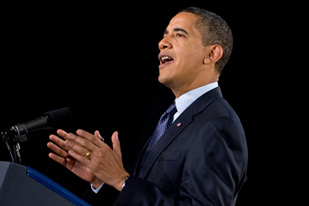 WASHINGTON — Shifting U.S. objectives in Afghanistan away from the Bush administration’s promise to build a Western-style democracy, President Barack Obama will announce on Friday that he’s deploying thousands of additional American troops and civilians to achieve more modest goals, such as enhancing security and promoting economic development, U.S. officials said.
WASHINGTON — Shifting U.S. objectives in Afghanistan away from the Bush administration’s promise to build a Western-style democracy, President Barack Obama will announce on Friday that he’s deploying thousands of additional American troops and civilians to achieve more modest goals, such as enhancing security and promoting economic development, U.S. officials said.
The announcement comes days before Obama heads to Europe to ask allies for more troops, civilians, and money in the eight-year war against the Taliban and al Qaida. It also comes as the U.S. prepares to deploy as many as 17,500 more troops to Afghanistan to reclaim the U.S. stake in a fight that’s languished as the Bush administration focused on Iraq.
The new strategy will call for an additional 4,000 troops from the 4th brigade, 82nd Airborne Division out of Fort Bragg, N.C., to train Afghan forces, U.S. officials said. As the administration trickles in more forces, it will also “surge” of hundreds diplomats and civilian specialists to help run elections, fighting rampant corruption and battle increased narcotics trafficking. It also calls for tripling economic aid to Pakistan.
Three administration officials said that they also expect NATO countries to promise more troops during the president’s visit overseas next week. The officials briefed reporters Thursday on the condition of anonymity because the president hadn’t yet made his plans public.
Obama also briefed members of Congress and called Afghan President Hamid Karzai and Pakistan President Asif Ali Zardari on Thursday to brief them on his strategic review, telling everyone involved that the U.S. commitment there was “not a blank check.”
To succeed, however, the administration’s strategy must address the growing Islamic militancy in neighboring, nuclear-armed Pakistan, which is a source of supplies, haven and training for Afghan militants, and the rampant corruption of Karzai’s U.S.-backed regime.
Yet it appears the strategic review doesn’t resolve how to stop Pakistan’s pervasive influence in Afghanistan. Despite weeks of compiling review reports and promises of addressing that, “I don’t think (the administration) knows what to do in Pakistan,” a senior U.S. official who participated in the review told McClatchy.
Indeed, an administration official who briefed reporters acknowledged that, “In many ways Pakistan is the hardest part of this problem.”
Instead, the review calls for an additional $1.5 billion in economic aid over five years to Pakistan. Obama will seek to engage countries with a stake in the conflict, including Russia, China, Saudi Arabia, the United Arab Emirates and Iran.
The Obama administration has called for a regional approach to the Afghanistan problem since many Taliban fighters are protected by elements of Pakistan’s military and intelligence services. Most U.S. officials concede, however, that stopping fighters from crossing the long, mountainous border is difficult.
At the same time, according to some of the experts who helped frame the new strategy, the U.S. military must rapidly adjust its tactics, equipment and procedures to conditions in Afghanistan, which differ sharply from those in Iraq, and U.S. intelligence agencies must quickly improve their knowledge of local power structures in the country.
And while officials could not say how much more the Afghanistan strategy would cost, they estimated it could rise as much as 60 percent from its $2 billion monthly tab. According to the Defense Department, the U.S. has spent about $118.2 billion on the war in Afghanistan as of September.
Although the president said last week in an interview on CBS’s “60 Minutes” that the U.S. needed an exit strategy, an administration official said there will not be a withdrawal timeline. Instead, the U.S. will measure its progress through benchmarks, which the administration hasn’t outlined.
Navy Adm. Dennis Blair, the nation’s highest-ranking intelligence official, told on reporters on Thursday that the administration will launch an integrated civilian and military campaign in Afghanistan that addresses both local and national issues in the country.
He said about a third of the Taliban’s Afghan followers support Taliban leader Mohammed Omar’s Pakistan-based campaign to re-impose strict Islamic rule on Afghanistan. The rest, U.S. officials believe, join to earn money or to address local problems.
Blair said that U.S. intelligence agencies have been analyzing Afghanistan “district-by-district,” but he conceded that the U.S. lacks the detailed intelligence on local power structures and other issues that will be needed to support civilian and military efforts to engage the local populations, support the central government and undermine the Taliban. “The tactical intelligence that’s needed to support operations needs to be ramped up,” he said.
He acknowledged that Pakistan’s Inter-Services Intelligence agency has had strong ties to the Taliban in the past, but he added that three weeks ago a Pakistani delegation participated in the administration’s strategic review of U.S. policy toward Afghanistan and Pakistan. The Pakistani government of Zardari “is adjusting both its strategy and its knowledge” of Mullah Omar’s Taliban militants, who are based near Quetta, in the country’s Baluchistan province, he said.
As the U.S. military focused its resources on Iraq, the Taliban expanded its hold over parts of Afghanistan and Pakistan. Its forces moved back into provinces near the capital, Kabul, and Afghanistan’s largest city, Kandahar. If allowed to prevail, the Taliban could once again turn Afghanistan into a haven for terrorists to plot attacks in the U.S., the administration has argued.
The streamlined goal is “to disrupt, dismantle and defeat al Qaida,” a senior administration official said on Thursday.
Beside securing the population, U.S. and NATO forces train their Afghan counterparts to double the number of soldiers and police to 134,000 and 82,000, respectively.
In giving a leading role to civilian specialists and to the U.N., Obama is making a sharp break from the Bush administration, which excluded both from early postwar efforts in Iraq after the U.S.-led invasion there six years ago. So far, the military has led the U.S. efforts in Afghanistan.
The Bush administration began conducting strategies reviews in the last weeks of his presidency and the Obama administration also conducted reviews. But there have been tensions about what the U.S. can realistically achieve.
Some, including Vice President Joe Biden, have called for modest goals that wouldn’t stop the Taliban from setting up training camps. Others, including U.S. Central Command Commander Gen. David Petraeus, the former Iraq commander, have called for a counterinsurgency tactic, which would target the fighters.
The strategy review puts new challenges before the Pentagon. How should the U.S. military shift its training and equipment from Iraq to Afghanistan? How much can the Defense Department expect in funding during this economic crisis? And how effectively can the U.S. withdraw from Iraq and move into Afghanistan?
 Eurasia Press & News
Eurasia Press & News


